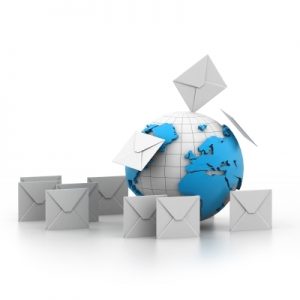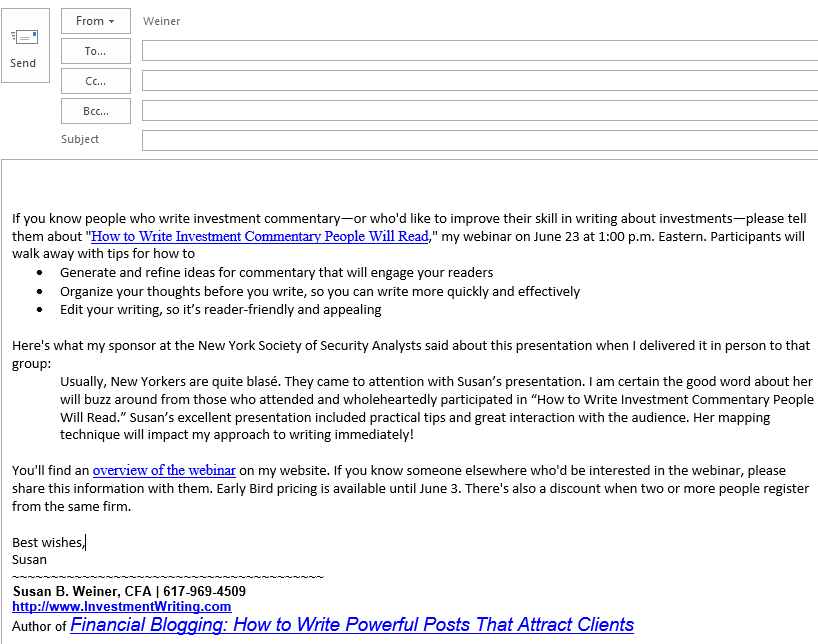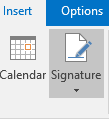Email productivity booster for investment and wealth management
Whether you’re an investment or wealth manager—or a professional or vendor who supports them—you can probably benefit from an email productivity booster. Take advantage of Microsoft Outlook’s “signature” feature to summon up basic email templates at the click of a button. I imagine that other email programs may offer a similar feature.
Writing emails from scratch is a productivity killer
 If you’re like most of us, you have emails that you send repeatedly, with minimal variations. Maybe it’s a prospecting email. Or a new-client welcome email. Or an email asking if you can update the recipient’s contact information.
If you’re like most of us, you have emails that you send repeatedly, with minimal variations. Maybe it’s a prospecting email. Or a new-client welcome email. Or an email asking if you can update the recipient’s contact information.
You shouldn’t start from scratch every time you write an email. You waste time repeating steps that you’ve already gone through many times before. Sure, you can save templates in your word-processing software, but it’s even more efficient to use one of Microsoft Outlook’s underappreciated features, the signature.
Email productivity booster: Microsoft Outlook’s signature feature
Did you know that you can save an entire model letter in Microsoft Outlook as a so-called “signature”? Most people use Outlook’s signature feature to insert classic signature information, such as your name, contact information, and other promotional information details that go under where you sign off with your name. But, as I learned from organizer Lorena Prime, you can use the Outlook signature for much more.
As you’ll see in the image below, I turned an entire email into an Outlook signature.

After loading an email as an Outlook signature, it’s easy to customize and send.

Go to the Insert tab, then click on Signature to view a drop-down menu of the signatures you’ve previously saved.
I simply go to Outlook’s Insert tab, click on Signature, and then select by title the text that I want to use. After filling in my “To” and “Subject” lines, and adding a greeting, I’m ready to hit “Send.”
This is way faster and easier than writing an email from scratch. It’s even easier than copy-pasting from a Word file because I’d probably forget where I saved the dratted model email.
Here’s what Microsoft says about creating signatures in Outlook 2013, 2016, or 2019.
YOUR email productivity booster ideas?
If you have ideas for boosting email productivity, please share them.
Of course, sometimes the best productivity booster is to keep your email closed and pick up the phone for a quick solution to a pressing problem.
Image courtesy of ddpavumba/FreeDigitalPhotos.net
NOTE: I made some minor editorial tweaks on Dec. 30, 2019.



Hi Susan
I do something similar, however I just save the content in my drafts folder and click forward with my new recipients email address.
With the signature function you also can’t upload attachments.
Hi Reagan,
That’s a good point about attachments. Saving the content in your drafts folder is definitely better for those emails.
Thank you for taking the time to comment!
Great idea! Thanks for sharing Susan! I might adapt it a bit as Reagan suggests, but a great timesaver!
Bob, I’m glad you found it useful. This has saved me lots of time.
Thank you for taking time to comment!
I use an app for Mac called TextExpander. You can create any block of text and associate it with a shortcut keystroke phrase. A similar app for Windows is PhraseExpress.
For example, whenever I need to introduce two people via email, I type my shortcut “.intro” and it expands to:
I am writing to introduce the two of you to each other.
_ is _ for _. You can see a brief background description of _ here:
_ is _ of _. You can see his profile page here:
I copied both of you in this message so you have your respective email addresses. I’ll let you two take it from here!
Why the period before intro? It’s like a mnemonic device to remember that I’m typing one of my special “dot” phrases. I can’t claim the invention of dot phrases. The idea comes from electronic medial record systems used in hospitals.
Bill,
Thanks for sharing your approach. As a Windows user, I should check out PhraseExpress.
Susan,
Outlook has a built-in template feature that includes the ability to send messages with attachments. Create a template by typing a message, and clicking on file/save as/outlook template. We save all of our templates in a shared folder. Add the “choose form” button to the quick access toobar, and then select “user defined templates” option. You have to configure the tempate folder in MS Word in the file/options/save menu. Our workflows reference the templates, and it makes completing tasks easy and consistent for all clients. Here’s a link: https://support.office.com/en-us/article/Create-an-email-message-template-43ec7142-4dd0-4351-8727-bd0977b6b2d1
Tim,
Thank you for the information, including the link! I wasn’t aware of the template in Outlook. I will check it out.